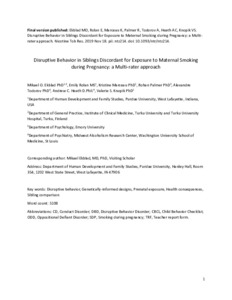Disruptive Behavior in Siblings Discordant for Exposure to Maternal Smoking during Pregnancy: a Multi-rater approach
Ekblad MO; Rolan E; Marceau K; Palmer R; Todorov A; Heath AC; Knopik VS
https://urn.fi/URN:NBN:fi-fe2021042824454
Tiivistelmä
Maternal smoking during pregnancy (SDP) is associated with disruptive behavior. However, there is debate whether the SDP-disruptive behavior association is a potentially causal pathway or rather a spurious effect confounded by shared genetic and environmental factors.
The Missouri Mothers and Their Children Study is a sibling comparison study that includes families (n = 173) selected for sibling pairs (aged 7–16 years) discordant for SDP. Critically, the sibling comparison design is used to disentangle the effects of SDP from familial confounds on disruptive behavior. An SDP severity score was created for each child using a combination of SDP indicators (timing, duration, and amount of SDP). Multiple informants (parents and teachers) reported on disruptive behavior (i.e., DSM-IV semi-structured interview, the Child Behavior Checklist, and Teacher Report Form).
The variability in disruptive behavior was primarily a function of within-family differences (66%–100%). Consistent with prior genetically informed approaches, the SDP–disruptive behavior association was primarily explained by familial confounds (genetic and environmental). However, when using a multi-rater approach (parents and teachers), results suggest a potentially causal effect of SDP on disruptive behavior (b = 0.09, SE = 0.04, p = 0.03). The potentially causal effect of SDP remained significant in sensitivity analyses.
These findings suggest that familial confounding likely plays a complex role in the SDP–disruptive behavior association when examining both parent and teacher reports of behavior. Importantly, the current study highlights the importance of multiple raters, reflecting a more comprehensive measure of complex behaviors (e.g., disruptive behavior) to examine the teratogenic effects of SDP.
Our study provides additional evidence that controlling for genetic and family factors is essential when examining the effect of SDP on later behavioral problems, as it explains a portion of the association between SDP and later behavioral problems. However, we found a significant association between SDP and disruptive behavior when using a multi-rater approach that capitalizes on both parent and teacher report, suggesting that parent and teacher ratings capture a unique perspective that is important to consider when examining SDP–behavior associations.
Kokoelmat
- Rinnakkaistallenteet [27094]
